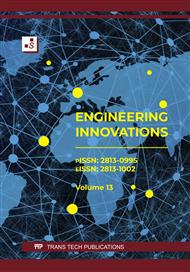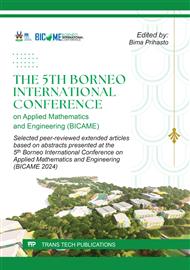[1]
Schulze DG., 2005. Encyclopedia of Soils in the Environment. ScienceDirect
Google Scholar
[2]
USDA., 1998. Natural Resources Conservation Service. Soil Quality Indicators: pH. http://www.isuvaslui.ro.
Google Scholar
[3]
Zang F., Wang S., Nan Z., Ma J., Zhang Q., Chen Y., Li Y.,2017. Accumulation, Spatio-Temporal Distribution, and Risk Assessment of Heavy Metals in the SoilCorn System Around a Polymetallic Mining Area from the Loess Plateau, Northwest China. Geoderma 305, 188–196.
DOI: 10.1016/j.geoderma.2017.06.008
Google Scholar
[4]
Fei, X.,Lou, Z., Xiao R., Ren, Z., Lv, X.,2020. Contamination Assessment and Source Apportionment of Heavy Metals in Agricultural Soil through the Synthesis of PMF and GeogDetector Models. Sci. Total Environ. 747,141293.
DOI: 10.1016/j.scitotenv.2020.141293
Google Scholar
[5]
Sutherland RA., Tolosa CA., Tack FMG., Verloo MG.,2000. Characterization of selected element concentration and enrichment ratios in background and anthropogenicallyimpacted roadside areas, Archives of Environmental Contamination and Toxicology, Vol.38, 428–438
DOI: 10.1007/s002449910057
Google Scholar
[6]
Guo, M.,2009. Soil sampling and methods of analysis. J. Environ. Qual.
Google Scholar
[7]
Zheng, W.,2004. The Technical Specification For Soil Environmental Monitoring (HJ/T 166–2004); Chinese Standard: Beijing, China,p.4–17.
Google Scholar
[8]
Akhter, MS., Madany, IM.,1993. Heavy metals in street and house dust in bahrain. Water Air Soil Pollut. : 66,111–119
DOI: 10.1007/bf00477063
Google Scholar
[9]
Hani, A.,Pazira, E.,2011. Heavy metals assessment and identification of their sources in agricultural soils of Southern Tehran, Iran. Environ. Monit. Assess. 176, 677–691. https://doi.org/10.1007/s10661-010- 1612-3
DOI: 10.1007/s10661-010-1612-3
Google Scholar
[10]
Huang, W., Campredon, R., Abrao, JJ., Bernat, M., Latouche, C.,1994. Variation of heavy metals in recent sediments from Piratininga Lagoon (Brazil): Interpretation of geochemical data with the aid of multivariate analysis. Environ. Geol. 23, 241–247.
DOI: 10.1007/bf00766738
Google Scholar
[11]
Hu., KL., Zhang, FR., Lu, YZ.,Wang, R.,Xu, Y.2011. Spatial distribution of concentrations of soil heavy metals in Daxing county, Beijing. Acta Sci. Circum. 24, 463–469
Google Scholar
[12]
Ruiz F., González-Regalado ML., Borrego J., Morales JA., Pendón JGP., Muñoz JM.,1998. Stratigraphic sequence, elemental concentrations and heavy metal pollution in Holocene sediments from the Tinto-Odiel Estuary, southwestern Spain. Environ. Geol. 34, 270–278.
DOI: 10.1007/s002540050278
Google Scholar
[13]
Yang P., Mao R., Shao H., Gao Y., 2009. The spatial variability of heavy metal distribution in the suburban farmland of Taihang Piedmont Plain, China. C. R. Biol. 332, 558–566.
DOI: 10.1016/j.crvi.2009.01.004
Google Scholar
[14]
Franco-Urıa A., Lopez-Mateo C., Roca E., Fernandez-Marcos, ML.,2009. Source identification of heavy metals in pastureland by multivariate analysis in NW Spain. J. Hazard. Mater. 165, 1008–1015.
DOI: 10.1016/j.jhazmat.2008.10.118
Google Scholar
[15]
Yao R J., Yang J., Gao P., Shao H., Chen X., Yu S., 2013. Multivariate simulation and assessment of three dimensional spatial patterns of coastal soil salinity using ancillary variables. Fresenius Environ. Bull. 22, 39–52.
Google Scholar
[16]
Silva., MTB., Hermo B S., García-Rodeja, E., Freire, NV.,2005. Reutilization of granite powder as an amendment and fertilizer for acid soils. Chemosphere.61(7):993–1002.
DOI: 10.1016/j.chemosphere.2005.03.010
Google Scholar
[17]
Mehta, N., Cocerva, T., Cipullo, S., Padoan, E., Dino, G A., Ajmone-Marsan, F., Cox, S F., Coulon, F., De Luca, D A., 2019. Linking oral bioaccessibility and solid phase distribution of potentially toxic elements in extractive waste and soil from an abandoned mine site: Case study in Campello Monti, NW Italy. Science of the Total Environment, 651, 2799-2810.
DOI: 10.1016/j.scitotenv.2018.10.115
Google Scholar
[18]
Magaly G Valencia-Avellan, Rebecca Slack, A E, B Anthony Stockdale C., Robert John George Mortimer .,2017. Effect of episodic rainfall on aqueous metal mobility from historical mine sites Environ. Chem. 14, 469–475
DOI: 10.1071/en17133
Google Scholar
[19]
Kahle, M., M. Kleber, and R. Jahn. 2002. Review of XRD Based Quantitative Analysis of Clay Minerals in Soils: The Suitable of Mineral Intensity Factor. Geoderma109:191-205
DOI: 10.1016/s0016-7061(02)00175-1
Google Scholar
[20]
Kadir S., Adogan M S, Elitok O, Helvaci C,,2015.Composition and Genesis of the Nickel-Chrome- Bearing Nontronite and Montmorillonite in Lateritized Ultramafic Rocks in the Muratdği Region (Uşak, Western Anatolia), Turkey Clays and Clay Minerals volume 63, pages 163–184
DOI: 10.1346/ccmn.2015.0630302
Google Scholar
[21]
Moore, D M., Reynold, R C., 1997. X-Ray Diffraction and the Identification and Analysis of Clay Mineral. Oxford University Press, Oxford.
Google Scholar
[22]
Blackmore, L C., Searle P L., Daly B K., 1981. Methods for chemicals analysis of soils. N. Z. Soil Bureau Sci. Rep. 10A. Soil Bureau, Lower Hutt. New Zealand.
Google Scholar
[23]
Jianwei Bu., Ziyong Sun ., Aiguo Zhou ., Youning Xu ., Rui Ma ., Wenhao Wei., Meng Liu.,2016.Heavy Metals in Surface Soils in the Upper Reaches of the Heihe River, Northeastern Tibetan Plateau, China. International Journal of Environmental Research and Public Health. MDPI
DOI: 10.3390/ijerph13030247
Google Scholar
[24]
Rayment, GE., Higginson FR., 1992. Australian laboratory handbook of soil and water chemicals methods. Australian soil and land survey handbook. Inkata Press, Melbourne, Sydney
Google Scholar
[25]
Scragg A.,2006. Environmental Biotechnology, Oxford University Press, Oxford, UK, 2nd edition
Google Scholar
[26]
Schindler M, Mantha H, Hochella Jr MF,2019.The formation of spinel-group minerals in contaminated soils: the sequestration of metal(loid)s by unexpected incidental nanoparticles.V. 20:1 Geochemical Transactions
DOI: 10.1186/s12932-019-0061-3
Google Scholar
[27]
Lasat M M., 2000. Phytoextraction of metals from contaminated soil: a review of plant/soil/metal interaction and assessment of pertinent agronomic issues. Journal of Hazardous Substances Research, vol. 2, p.1–25
DOI: 10.4148/1090-7025.1015
Google Scholar
[28]
Jones L H P., Jarvis S C., 1981. The fate of heavy metals in The Chemistry of Soil Processes, Green D J., Hayes M H B., Eds., p.593, John Wiley & Sons, New York, NY, USA
Google Scholar
[29]
Raven P H., Berg R., Johnson G B.,1998. Environment. Saunders College Publishing, New York, NY, USA, 2nd edition
Google Scholar
[30]
Bowles J F W., 2021. Encyclopedia of Geology (Second Edition), Scinecedirect
Google Scholar
[31]
Miguel Ángel Olego .,Miguel Javier Quiroga ., Cristina Mendaña-Cuervo ., Jorge Cara-Jiménez ., Roberto López 3 and Enrique Garzón-Jimeno,2021.Long-Term Effects of Calcium-Based Liming Materials on Soil Fertility Sustainability and Rye Production as Soil Quality Indicators on a Typic Palexerult.Processes,9:1181, MDPI
DOI: 10.3390/pr9071181
Google Scholar
[32]
Michael Schindler., Haley Mantha ., Michael F. Hochella Jr.,2021.The formation of spinel-group minerals in contaminated soils: the sequestration of metal(loid)s by unexpected incidental nanoparticles Geochemical Transactions,20:1
DOI: 10.1186/s12932-019-0061-3
Google Scholar
[33]
Das S K., Chakrapani G J., 2011. Assessment of trace metal toxicity in soils of Raniganj Coalfield, India Environ Monit Assess 177: 63–71
DOI: 10.1007/s10661-010-1618-x
Google Scholar
[34]
Antonio G. Caporale1., Antonio Violante., 2016. Chemical Processes Affecting the Mobility of Heavy Metals and Metalloids in Soil Environments Curr Pollution Rep (2016) 2:15–27
DOI: 10.1007/s40726-015-0024-y
Google Scholar
[35]
Santos A., Alonso E., Callejon M., Jimenez J C., 2002.Distribution of Zn, Cd, Pb and Cu metals in groundwater of the Guadiamar river basin. Water Air and Soil Pollution,134(1–4), 273–283
Google Scholar
[36]
Bell F G., Stacey T R., Genske D D.,2000. Mining subsidence and its effect on the environment: some differing examples. Environmental Geology, 40(1–2), 135–152
DOI: 10.1007/s002540000140
Google Scholar
[37]
Lizárraga-Mendiola L., González-Sandoval M R., Durán Domínguez M C., Márquez-Herrera C., 2009. Geochemical behavior of heavy metals in a Zn–Pb–Cu mining area in the State of Mexico (central Mexico). Environmental Monitoring and Assessment, 155, 355–372
DOI: 10.1007/s10661-008-0440-1
Google Scholar
[38]
Filius A., Streck T., Richter J., 1998. Cadmium sorption and desorption in limed topsoils as influenced by pH: Isotherms and simulated leaching. J. Environ. Qual. 27, 12–18.
DOI: 10.2134/jeq1998.00472425002700010003x
Google Scholar
[39]
McBride, M. B., Suave, S., Hendershot, W., 1997. Solubility control of Cu, Zn, Cd, and Pb in contaminated soils. European J. Soil Sci. 48, 337–346
DOI: 10.1111/j.1365-2389.1997.tb00554.x
Google Scholar
[40]
Behzad Mehrabi., Shiva Mehrabani., Behrouz Rafiei., Behrouz Yaghoubi., 2015.Assessment of metal contamination in groundwater and soils in the Ahangaran mining district, west of Iran. Environ Monit Assess 187: 727
DOI: 10.1007/s10661-015-4864-0
Google Scholar
[41]
Adriano DC.,1986. Trace elements in the terrestrial environment (p.533). New York: Springer
Google Scholar
[42]
Facchinelli A., Sacchi E., Mallen L.,2001. Multivariate statistical and GIS-based approach to identify heavy metal sources in soils. Environmental Pollution, 114, 313–324
DOI: 10.1016/s0269-7491(00)00243-8
Google Scholar
[43]
Loska K., Wiechula D., 2003. Application of principal component analysis for the estimation of source of heavy metal contamination in surface sediments from the Rybnik Reservoir. Chemosphere, 51, 723– 733
DOI: 10.1016/s0045-6535(03)00187-5
Google Scholar
[44]
Emma Sandell Festin., Mulualem Tigabu ., Mutale N., Chileshe., Stephen Syampungani., Per Christer Ode´n.,2019. Progresses in restoration of post-mining landscape in Africa. J. For. Res. 30(2):381–396
DOI: 10.1007/s11676-018-0621-x
Google Scholar
[45]
Rankin W J.,2011. Minerals, metals and sustainability: meeting future material needs. CSIRO Pub, Collingwood
Google Scholar
[46]
Vela-Almeida D., Brooks G., Kosoy N.,2015. Setting the limits to extraction: a biophysical approach to mining activities. Ecol Econ 119:189–196
DOI: 10.1016/j.ecolecon.2015.09.001
Google Scholar
[47]
Carrick P J., Kru¨ger R., 2007. Restoring degraded landscapes in lowland Namaqualand: lessons from the mining experience and from regional ecological dynamics. J Arid Environ 70:767–781
DOI: 10.1016/j.jaridenv.2006.08.006
Google Scholar
[48]
Golightly JP., 1979. Nickeliferous laterites: A general description, in Evans, D. J. I., Shoemaker, R. S. and Veltman, H., eds., International Laterite Symposium: New York, Society of Mining Engineers, p.3–23.
Google Scholar
[49]
Golightly J P., 1981. Nickeliferous Laterite Deposits., Economic Geology 75th Anniversary Volume p.710 – 735.
DOI: 10.5382/av75.18
Google Scholar
[50]
Elias M., 2002. Nickel laterite deposits - a geological overview, resources and exploitation: Hobart, University of Tasmania, Centre for Ore Deposit Research Special Publication 4, p.205–220.
Google Scholar
[51]
Marsh E., Anderson E., Gray F., 2013. Nickel-cobalt laterites—A deposit model, in U.S. Geological Survey Scientific Investigations Report.
DOI: 10.3133/sir20105070h
Google Scholar
[52]
Mustafa M., Maulana A., Irfan UR., Tonggiroh A., 2022.Determination of heavy metal elements concentration in soils and tailing sediments from lateritic nickel post-mining areas in Motui District, Southeast Sulawesi J. Degrade. Min. Land Manage. , pp.3273-3279
DOI: 10.15243/jdmlm.2022.092.3273
Google Scholar
[53]
Muller G., 1969. Index of geoaccumulation in sediments of the Rhine River. GeoJournal, 2, 108–118.
Google Scholar
[54]
Sahu A., Vishwakarma N., Singh Y., Verma C B., 2020. Mineral chemistry of high-Al chromian spinel from ultramafic rocks of the Babina–Prithvipur transect, Bundelkhand Craton, central India: Implication for petrogenesis and tectonic setting. Article number: 182 (2020) Journal of Earth System Science volume 129
DOI: 10.1007/s12040-020-01448-3
Google Scholar
[55]
Maulana A., Christy A G., Ellis D J., 2015. Petrology, geochemistry and tectonic significance of serpentinized ultramafic rocks from the South Arm of Sulawesi, Indonesia Chemie der Erde,75:1, 73-87
DOI: 10.1016/j.chemer.2014.09.003
Google Scholar
[56]
Tonggiroh A., Jaya A., Irfan UR., 2017. Type of nickel laterization, Lasolo fracture and mollase deposits of Southeast Sulawesi, Indonesia. Eco. Env. & Cons. 23 (1), pp. (97-103)
Google Scholar
[57]
Zhang Y., Qie J., Wang XF., Cui K., Fu T., Wang J., Qi Y., 2020. Mineralogical Characteristics of the Nickel Laterite, Southeast Ophiolite Belt, Sulawesi Island, Indonesia Mining, Metallurgy & Exploration 37:79–91
DOI: 10.1007/s42461-019-00147-y
Google Scholar
[58]
Zhang Z W., Wang Y L., Wang C Y., Qian B., Li W Y., Zhang J W., You M X., 2019. Mafic-ultramafic magma activity and copper-nickel sulfide metallogeny during Paleozoic in the Eastern Kunlun Orogenic Belt, Qinghai Province, China. China Geology v 2 : 4,pp.467-477
DOI: 10.31035/cg2018124
Google Scholar
[59]
Scoates J S., Scoates R F J., Wall C J., Friedan R M., Couëslan C G., 2017. Direct Dating of Ultramafic Sills and Mafic Intrusions Associated with Ni-Sulfide Mineralization in the Thompson Nickel Belt, Manitoba, Canada. Economic Geology 112 (3): 675–692.
DOI: 10.2113/econgeo.112.3.675
Google Scholar
[60]
Barnes S J., Lightfoot P C., 2005. Formation of Magmatic Nickel Sulfide Ore Deposits and Processes Affecting Their Copper and Platinum Group Element Contents. Society of Economic Geologists, Inc. 100th Anniversary Volume, p.000–000
DOI: 10.5382/av100.08
Google Scholar



